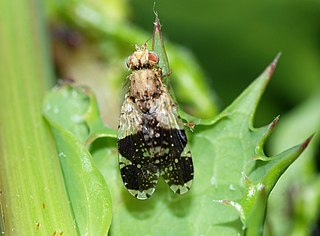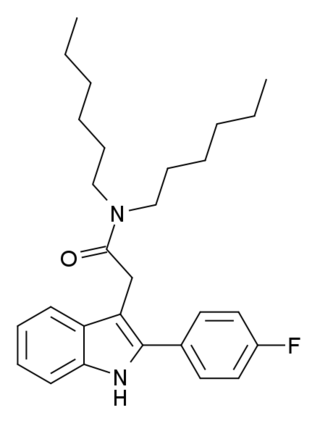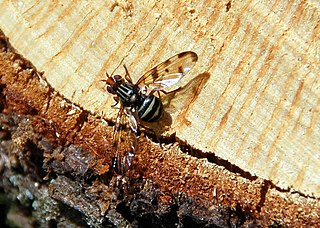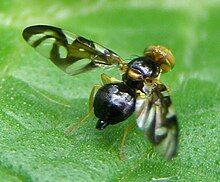
The Ulidiidae or picture-winged flies are a large and diverse cosmopolitan family of flies (Diptera), and as in related families, most species are herbivorous or detritivorous. They are often known as picture-winged flies, along with members of other families in the superfamily Tephritoidea that have patterns of bands or spots on the wings. Some species share with the Tephritidae an unusual elongated posteroapical projection of the anal cell in the wing, but can be differentiated by the smoothly curving subcostal vein. Two species, Tetanops myopaeformis and Euxesta stigmatias, are agricultural pests.

The Trypetinae are a subfamily of tephritid fruit flies.

The Pyrgotidae are an unusual family of flies (Diptera), one of only two families of Cyclorrhapha that lack ocelli. Most species are "picture-winged", as is typical among the Tephritoidea, but unlike other tephritoids, they are endoparasitoids; the females pursue scarab beetles in flight, laying an egg on the beetle's back under the elytra where the beetle cannot reach it. The egg hatches and the fly larva enters the body cavity of the beetle, feeding and eventually killing the host before pupating. In the United States, some species of Pyrgota and Sphecomyiella can be quite common in areas where their host beetles are abundant. Like their host beetles, these flies are primarily nocturnal, and are often attracted to artificial lights.
Andrey Korneyev was a breaststroke swimmer from Russia, who won the bronze medal in the men's 200 m breaststroke event at the 1996 Summer Olympics in Atlanta, United States. A year earlier he captured the gold medal in the same event at the 1995 European Championships in Vienna, Austria.

Konstantin Nikolayevich Korneyev is a Russian former professional ice hockey defenceman. He most recently played for Severstal Cherepovets of the Kontinental Hockey League (KHL).

Tephritis is a genus of flies. It contains around 170 described species, making it the sixth largest genus in the family Tephritidae. Many more undescribed species are known from specimen collections. Tephritis occur throughout much of the world, but most are Palearctic. They can be found in a wide range of climate types, from hot semidesert to tundra. Most species inhabit the inflorescences of plants from several tribes in the family Asteraceae, and a few species cause galls to form.

Terellia is a genus of tephritid or fruit flies in the family Tephritidae.

Urophora is a genus of tephritid or fruit flies in the family Tephritidae.
Euleia basihyalina is a species of tephritid or fruit flies in the genus Euleia of the family Tephritidae.
Euleia contemnens is a species of tephritid or fruit flies in the genus Euleia of the family Tephritidae.

Euleia heraclei, known as the celery fly or the hogweed picture-wing fly is a species of tephritid or fruit flies in the genus Euleia of the family Tephritidae.
Euleia latipennis is a species of tephritid or fruit flies in the genus Euleia of the family Tephritidae.
Euleia fratria is a species of tephritid or fruit flies in the genus Euleia of the family Tephritidae. The species was first classified in 1862, and is native to North America.
Euleia marmorea is a species of tephritid or fruit flies in the genus Euleia of the family Tephritidae.
Euleia nemorivaga is a species of tephritid or fruit flies in the genus Euleia of the family Tephritidae.
Euleia uncinata is a species of tephritid or fruit flies in the genus Euleia of the family Tephritidae.

FGIN-1-27 is an anxiolytic drug which acts as a selective agonist at the peripheral benzodiazepine receptor, also known as the mitochondrial 18 kDa translocator protein or TSPO. It is thought to produce anxiolytic effects by stimulating steroidogenesis of neuroactive steroids such as allopregnanolone.

Otitinae is the name of a subfamily of flies in the family Ulidiidae. It was formerly the Otitidae. Like the Ulidiinae, most species are herbivorous or saprophagous. Most species share with the Tephritidae an unusual elongated projection of the anal cell in the wing, but can be differentiated by the smoothly curving subcostal vein. Most are dull gray to shiny brown or black flies with vein R1 setulose or, in a few cases, bare.
The Man Who Doesn't Return is a 1991 Soviet drama film directed by Sergey Snezhkin. This fictional film's plot features a planned coup against the Soviet government. By coincidence, this made the film very topical because while it filmed beforehand, it was released and aired on television on August 20 1991 during a real coup in the Soviet Union, one that lead to the Soviet Union's demise later that year.

Myopitini is a tribe of tephritid or fruit flies in the family Tephritidae.










